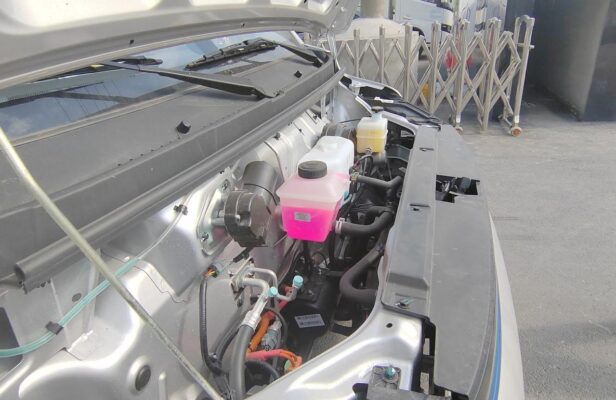ელექტრო სატვირთო ახალი ამბები
Power battery system temperature step test
გამოქვეყნებულია მიერ ელექტრო სატვირთო მანქანები
The power battery system is a crucial component of many modern technologies, from electric vehicles to renewable energy storage systems. Ensuring its performance and reliability under various conditions is essential for the safe and efficient operation of these systems. One important aspect of evaluating the power battery system is understanding its response to temperature changes. This is where the temperature step test comes into play.

The temperature step test aims to comprehensively assess the response and performance of the power battery system in an environment with gradually changing temperatures. This test is designed to mimic the real-world conditions that the battery system may encounter, as temperatures can vary significantly depending on the operating environment and usage patterns.
The test is typically carried out by placing the battery system in a series of controlled environments with different temperatures. Each temperature stage is maintained for a certain period of time to allow the battery system to reach a stable state and to simulate actual temperature change working conditions. During this process, a variety of parameters such as the temperature, voltage, current, and capacity of the battery system are closely monitored and recorded.

მაგალითად, the battery system may be first placed in an environment with a relatively low temperature, say 0 degrees Celsius, and left there for a specific duration, such as two hours. Then, the temperature is gradually increased to a moderate level, such as 25 degrees Celsius, and again maintained for a set period. This process continues with further increases in temperature or decreases as per the test plan. By systematically changing the temperature and observing the battery system’s response, valuable insights can be gained into its behavior under different temperature conditions.
The monitoring and recording of parameters are crucial as they provide quantitative data that can be analyzed to understand the battery system’s performance. Temperature sensors are used to measure the actual temperature of the battery system at different locations to ensure uniformity and detect any hot spots. Voltage and current measurements help determine the electrical characteristics of the battery, such as its charging and discharging behavior. Capacity measurements provide an indication of the amount of energy that the battery can store and release, which is directly related to its performance and useful life.

Temperature steps can have a significant impact on the physical and chemical properties of the power battery system. As the temperature changes gradually from one stage to another, the internal components of the battery system experience thermal expansion and contraction. This can lead to non-uniformity of physical and chemical changes inside the battery.
At different temperature stages, the materials within the battery, such as the electrodes and electrolytes, may expand or contract at different rates. This can cause stress and deformation within the battery structure, which in turn can affect the connectivity and performance of battery components. მაგალითად, if the electrodes expand too much due to a temperature increase, they may crack or delaminate from the current collector, reducing the electrical contact and affecting the battery’s performance.

In addition to structural changes, temperature changes also have a profound effect on the internal reaction rate of the battery. The electrochemical reactions that occur within the battery are highly temperature-dependent. As the temperature increases, the reaction rate generally increases, which can lead to changes in the battery’s voltage, current, and capacity. თუმცა, this may not always be beneficial. High temperatures can also accelerate the degradation of battery materials and cause capacity attenuation and fluctuations in power output.
მაგალითად, at high temperatures, the electrolyte may decompose more rapidly, reducing the battery’s lifespan. მეორე მხრივ, at low temperatures, the reaction rate slows down, which can lead to reduced power output and capacity. This can be a particular problem for applications such as electric vehicles, where consistent power output is essential for reliable operation.

In order to accurately assess the performance of the power battery system under temperature step changes, several common evaluation indicators are used.
-
Temperature response: This indicator focuses on observing the temperature change speed and stability of the battery system under temperature step changes. The speed at which the battery system responds to temperature changes can provide insights into its thermal management capabilities. A rapid temperature change may indicate poor insulation or ineffective cooling/heating systems. მეორე მხრივ, a slow response may suggest that the battery system is well-insulated but may take longer to reach optimal operating temperatures. Stability refers to the ability of the battery system to maintain a relatively constant temperature once it reaches a particular stage. Fluctuations in temperature can indicate issues with the temperature control system or internal heat generation.
-
Power output stability: This evaluation criterion assesses the power output capacity and stability of the battery system at different temperature stages. Power output stability is crucial for applications where a consistent supply of power is required, such as in electric vehicles or backup power systems. Fluctuations in power output can lead to performance issues and may even damage connected devices. By measuring the power output at different temperatures and observing its stability, engineers can determine if the battery system is capable of meeting the power requirements under various temperature conditions.
-
Capacity attenuation: Capacity attenuation is a key indicator for evaluating the life characteristics of the battery system. During the temperature step change process, the battery’s capacity may change due to various factors such as temperature-induced degradation of materials and changes in internal resistance. Measuring the capacity loss of the battery system at different temperature stages can help determine its long-term durability and predict its useful life. მაგალითად, if the battery experiences significant capacity loss at high temperatures, it may not be suitable for applications in hot climates or environments where high temperatures are common.
-
Effectiveness of temperature control strategy: The temperature control strategy of the battery system is designed to maintain the battery within a certain temperature range to ensure optimal performance and longevity. In the temperature step test, the effectiveness of this strategy can be evaluated by observing how well the battery system responds to temperature changes and how quickly it returns to the desired temperature range. If the temperature control system is ineffective, the battery may experience excessive temperature fluctuations, which can lead to reduced performance and accelerated degradation.

D. Implementation and analysis of results
The temperature step test needs to be carefully planned and executed to ensure accurate and reliable results. The test should be carried out according to a predetermined temperature change law, such as gradually increasing or decreasing the temperature at a specific rate. This can be achieved using temperature-controlled chambers or other environmental testing equipment.
During the test, relevant data should be recorded continuously to capture the battery system’s response at different temperature stages. This includes temperature, voltage, current, capacity, and any other parameters that are relevant to the evaluation. The recorded data can then be analyzed to understand the battery system’s performance under temperature step changes.

Analysis of the test results can reveal valuable information about the performance stability, capacity attenuation trend, and the effectiveness of the temperature control strategy of the battery system. მაგალითად, by plotting the temperature and capacity data over time, it is possible to observe how the battery’s capacity changes with temperature. If there is a significant drop in capacity at certain temperatures, it may indicate that the battery is sensitive to those temperatures and may require improved thermal management.
Similarly, by analyzing the power output data, it can be determined if the battery system is able to maintain a stable power output at different temperature stages. If there are fluctuations in power output, it may suggest issues with the battery’s internal components or the temperature control system.

According to the analysis results, the optimized design of the battery system and the improvement of the temperature management strategy can be carried out to improve its stability and reliability under actual working conditions. მაგალითად, if the analysis shows that the battery experiences excessive temperature fluctuations, modifications can be made to the insulation, cooling, or heating systems to improve temperature control. If there is significant capacity attenuation at certain temperatures, alternative materials or designs may be considered to enhance the battery’s durability.
დასასრულს, the temperature step test is a valuable tool for evaluating the performance of the power battery system under realistic temperature change conditions. By understanding the impact of temperature steps on the battery system and using appropriate evaluation indicators, engineers can gain insights into its behavior and make informed decisions for design and application. This can help ensure the reliability and performance stability of the battery system under different temperature conditions, which is crucial for the success of various technologies that rely on power batteries.